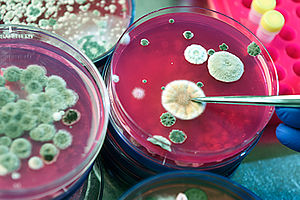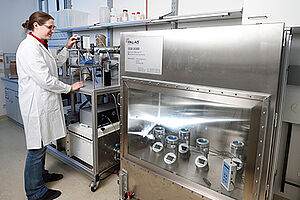Aerosol research deals with various particles that are present in the air. The core issues are collection, identification and the impact on humans, animals and the environment. In bioaerosol research, the focus is on biological substances, with pollen, fungal spores, viruses, bacteria and their components being the focus. They can occur as small individual particles, as aggregates or as mixtures of different organisms and dusts. Since the COVID-19 pandemic at the latest, the global public has been aware of the importance of bioaerosols.
One of our core topics is the correct detection of microorganisms in the air. In addition to classic microbiological methods, we use different collection devices and develop methods for the biomolecular detection of fungi, but also bacteria and virus particles. For example, we advance molecular detection methods for airborne mold spores based on microfluidic qPCR systems, develop specific molecular qPCR markers for the targeted identification of organisms or carry out microbiome studies.
For microbiome research and development in other environments, please see Plant Microbiome Applications
Bioaerosol chamber: validation of air collection devices
Another core competence is the validation of devices and processes for air purification as well as for the collection of biological material from the air. Our unique bioaerosol chamber is of central importance here. In this chamber it is possible to create controlled environmental conditions, such as a defined number of spores in the air, and to keep them constant over a long period of time. This makes it possible to compare and validate different collection devices, analysis methods and air purification strategies under controlled conditions. By classifying the bioaerosol laboratory as bio protection level 2, it is possible to work with a large number and diversity of microorganisms. They can be aerosolized over a wide range of concentrations, for which we have various aerosol generators. In addition to microorganisms, various test dusts (e.g. dust containing endotoxins) are also applied.
Allergens in the air
At Bioresources Unit we lay an additional focus on aeroallergen research, where we investigate airborne allergenic material such as pollen or fungal spores. We evaluate optimal collection methods for the detection of allergens and compare methods such as ELISA with other quantification methods, whereby our main focus is on fungi.
Organisms optimized for bioaerosol tests - selection from our strain collection:
| Pilze | Trichoderma longibrachiatum, Aspergillus sydowii, Aspergillus brasiliensis, Aspergillus amstellodami, Aspergillus fumigatus, Aspergillus protuberus, Penicillium rubens, Penicillium chrysogenum, Cladosporium cladosporioides, Cladosporium sphaerospermum, Cladosporium herbarum, Wallemia sebi |
| Bakterien | Bacillus amyloliquifaciens, Bacillus subtilis, Flavobacterium spp. |
| Hefezellen | Saccharomyces cervisiae |
| Phagen | PhiX174, Lambda |
Selected Projects
| CleanAir | Development and validation of a low-cost, mobile air cleaner with disinfection mode | EIT Manufacturing |
| BioAerosolKammer | Evaluation of a testing chamber and validation of various sampling- and analysis systems for bioaerosols | BioAerosolKammer |
| MolDeMould | Molecular detection of airborne mould by microfluidic qPCR | NFB Niederösterreichische Forschungs- und Bildungsges.m.b.H |
| AntigenSampling | Validation of the GSP-Filter and AS100-Microtiter sampling system for allergen detection in occupational settings | DGUV Forschungsförderung |
| SchimmelAntigenDetect | Validation of fungi specific ELISA – correlation between cell count (microscopy, qPCR), ELISA and CFU under controlled and reproducibel conditions | DGUV Forschungsförderung |
| Danube ARC | Danube Allergy Research Cluster | FWF Der Wissenschaftsfonds |






